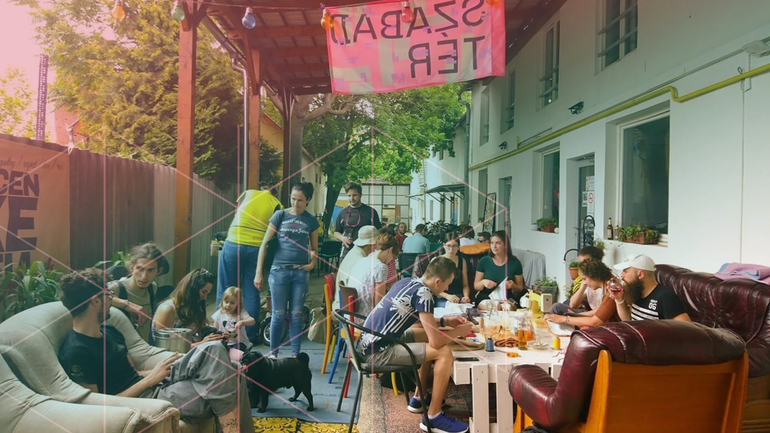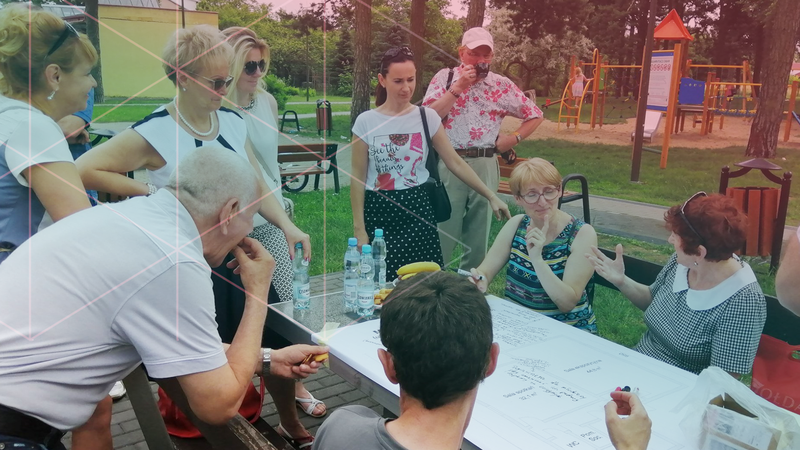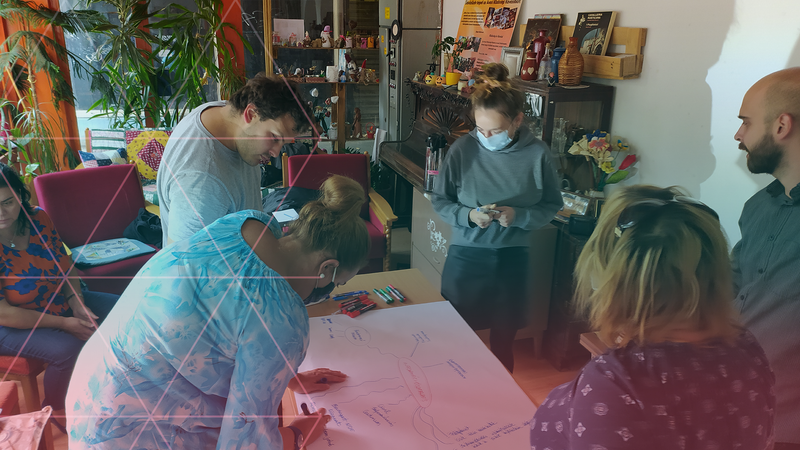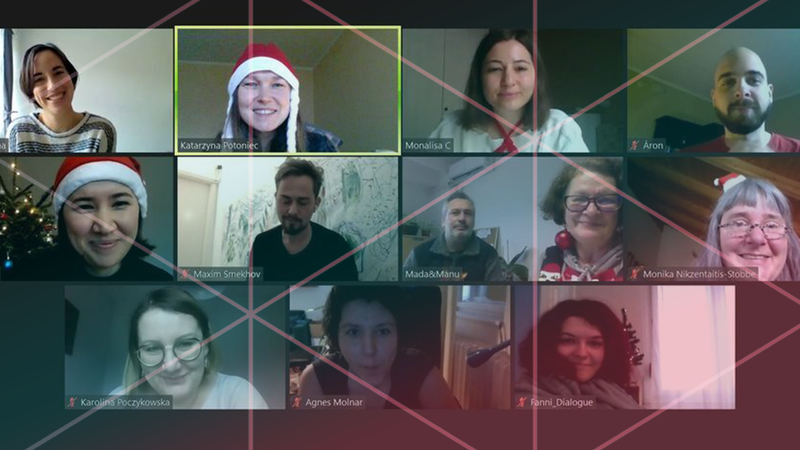The power of cooperation and co-creation

Snapshot of a regular afternoon in the Malter, Debrecen taken by Csaba Nyilas
1) Put individuals at the forefront
When beginning our Capacity Building program, we simply started with sharing stories and headed out into our “neighborhoods” as if we were not online at all. If you have ever experienced taking a town tour with an entirely dedicated guide who is really in love with every piece of architecture around, you might have felt this incredible passion that makes you curiously read several books and articles about the place afterwards. That was our experience in the breakout rooms full of cultural diversity, personal connections and energy. The title of the meeting was “Civic Europe Capacity Building – first partners’ meeting.” This kick-off of our partnership immediately made the first core principle of the program we were launching into apparent – putting individuals at the forefront.
It was not only about the personal connections, but about the common understanding that in order to cultivate social change programs in diverse settings, we need more than a well-described theory of change, budget, experts and innovative tools. We all need to work on creating a space where voices and experiences of people living with the problems and proximate actors in the system will be the most pivotal source in the search for higher leverage. Only with this approach we can think deeply about what is happening, explore options beyond popular thinking and, most importantly, learn together over time.
I remember the first time we were exposed to the community-building approach being used in the work of our partner in Romania. Madalina Ene, head of the PACT Foundation, presented their experience in community development as a part of the central organizational program Learning, Participation, Trust. In addition to unique forms of seed funding distribution, multilevel models of participative learning, diverse partnerships and constant peer support, PACT fosters reflection and conversation to enable an open dialogue that is uniquely grounded in the day-to-day experiences of the very people for whom their programs are created. Furthermore, they seem to have the unique capacity to accept people as they are, providing them the space to regulate their own initiatives and feel safe in being as authentic as possible. We have read about moral and sharing leadership before but their case is so inspiring because it is not an approach, but a way they live.

The opening of the Photos exhibition from 5 communities from the Southern Romania - "Together is at Home" by Valentin Boboc
2) Bridge your capacity with others’
Based on the MitOst experience working on capacity development for more than 20 years, we know that collaboration can have an utterly transformative impact. The example above demonstrates that mutual learning – where all participants of the process bring together their knowledge from a variety of contexts – opens supporting opportunities to increase effectiveness and magnify impact. From the very beginning of our partnership with the four cooperating program partners, we identified “co-creation” and the “shoulder-to-shoulder” approach as the bases for our strength-oriented capacity building and its further transfer to regional organizations and communities. We are gaining a greater awareness of our organizational and individual capacities by going through the process together and channeling our capacity into practical vehicles such as critical questions, needs-assessment tools, frameworks, methods and community-engaged learning offerings. These have the greater potential to reach broad audiences and address the roots of issues and challenges in the target regions and beyond.
3) Seek out diverse perspectives
Over the course of the interviews and the partner meetings, we observed that for our cooperation partners as well as our organization, diversity is not only an indicator like culture, gender, age or beliefs, but the value of differences in humans and their unique perspectives and ideas. Based on our experience at MitOst working with diverse groups, we understand that although it might be challenging, it makes the learning space and its outcomes very powerful. When participants generate ideas and design solutions for change, this diversity allows them to view the problem through multiple lenses, it sparks creativity and helps to adapt projects to the grassroot context and in that sense makes the designed solution more sustainable.
However, to shift from valuing diversity to also building diversity, we need practical actions and additional settings. Take, for example, our partner the OWOP Association from Poland. Along the way, we had been discussing the criteria for the selection of the participating organizations and groups in the Podlaskie region, developing a set of markers such as experience, capacity, commitment and community engagement, but we didn’t explicitly put the diversity of organizational backgrounds and thematic focuses in that set. However, when we looked at the final list of participating organizations in the region, it turned out that – thanks to an appreciative program promotion in remote areas of the region – it mirrored the variety of spectrums of local civil society organizations, ranging from LGBTQI communities to environmental associations.

Consultations on the development of the building of the NGO center in Grajewo by Karolina Poczykowska
This not only supports greater awareness of differences in the ecosystem and strengthens the inclusion of diverse voices from communities, but also creates stronger internal organizational culture related to diversity. Consequently, we expect that participants and organizations in their collaborative spaces will define mechanisms for gathering and listening to the standpoints of the communities they serve and thus join our passage to greater diversity, equity and inclusion within the Civic Europe program.
4) Practice trust and transparency
Trust building, like all important elements of relationship building, takes time. Our reflection culture gradually and organically shapes this relationship jointly with clear values and principles, open decision making and finally with a sense of belonging and ownership. In other words, we simply believe and practice what we cooperatively agreed upon.
For example, in one of our bilateral meetings with partners in Hungary, Agnes Molnar, from the Alternative Communities Association, raised the question about adapting the needs assessment tools to make them understandable for participants. She explained that even the use of the term “capacity building” for local communities may be confusing and make it harder to reach potential target groups. Furthermore, the name of the program “Civic Europe” doesn't appeal to participants, because the word “civic,” even when translated in the participants’ mother tongue, doesn’t have the same meaning as we, in an international context, understand it. Consequently, our partners adapted and simplified the wording in methods and changed the name of the program to make its narrative more inclusive.

Needs assessment workshop in Miskolc by Fanni Zselenák
That experience set the ground for further reflection on the wording we used in the entire Civic Europe program. We honestly questioned our inclusiveness in terms of playing with specific vocabulary and that discussion urged us to set up additional internal principles to guide us when we create a narrative or public message and serve as a filter to avoid misinterpretation.
Once established, trust is resilient. We may have an “award-winning” program, but our partners have the relationships, local expertise and commitment needed for our program to have impact. Locally, they have the lead – we learn with them and follow them.
For instance, we avoid controlling and monitoring by having clear boundaries where our interventions are not needed in combination with open and structured information flows. Regular meetings with all the partners keep us aware of what is actually happening and what kind of peer support is necessary to enhance the processes moving forward.
5) Value the process
An open feedback culture, where everyone is “cheered on” to share critical questions, concerns or insights about any program development we come up with, helps us to create a value-based learning process, shifting the focus from immediate outcomes to enduring change. This process requires long-term engagement and an adaptive theory of change, which corresponds to the historical background of the country, societal traditions, political context or just the emerging limitations caused by the pandemic. In our meetings, we spent time clarifying our map of the system to understand what was missing and what required further development. When we turned to find a solution, we had very different ideas and we have been working iteratively to bring them together in one combined, feasible structure. By investing a good deal of time into this process, we embrace system thinking, maximize our collaborative resources and finally clarify the missions of our organizations and the means of going towards them.

Picture from the Christmas party with partners of the Capacity Building program from Hungary, Poland and Romania in December 2020
In closing, I would like to say that the Civic Europe Capacity Building program isn't reinventing the wheel because we know that there are growing numbers of nonprofits around the world that practice such relationships. Nowadays when they virtually land in the “neighborhoods” of their partners during Zoom meetings, they kick-off and wrap-up with the questions “How do you feel?” and “What do you think?” We are just proud to be a part of this culture.